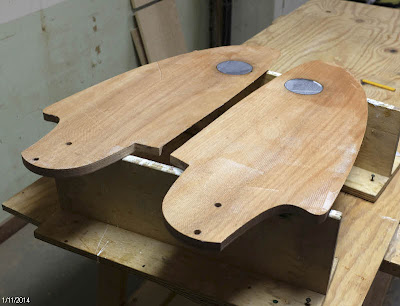Since last update I applied dynel fabric to the leading edge and bottom of the rudder and centerboard. Dynel is reputed to have very good abrasion resistance, and I put several layers on the parts that will drag first when the water gets thin. Shown here is the front corner of the centerboard.
I also cut, planed, and routed some stock for cleats to reinforce the joints where plywood pieces meet in the boat. These are just plain pine boards from Menards. I've got 80' prepared. There are some knots in this #2 lumber, but I will just cut around those and work with the clear wood. Yellow cedar is recommended, but not to be found around here. I will precoat these pieces with three coats of epoxy on the sides that will not be glued to other pieces.
Then I got started assembling the building jig. I set up the legs and started gathering pieces,
And held them in place with some clamps,
And spent quite a bit of time shimming and checking for level both lengthwise and crosswise.
Then I screwed the bottom to the legs, and screwed in cleats to hold the sides to the bottom. It stiffened up very nicely and now feels sturdy.
And ended the night by placing the first boat part on the jig - the hull bottom. I think the shop is going to start feeling pretty small soon...































